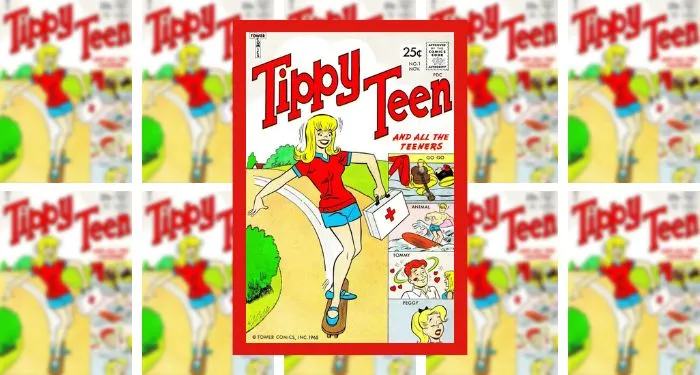
Retro Comic Rewind: Tippy Teen
Some comics go down in history as masterful examples of the craft and are beloved by multiple generations. And others end up at the landfill. In this series, I’ll be looking back on some forgotten series to better understand what kind of comics our ancestral nerds were reading in the days of rotary phones and record players.
Today’s subject: Tippy Teen!
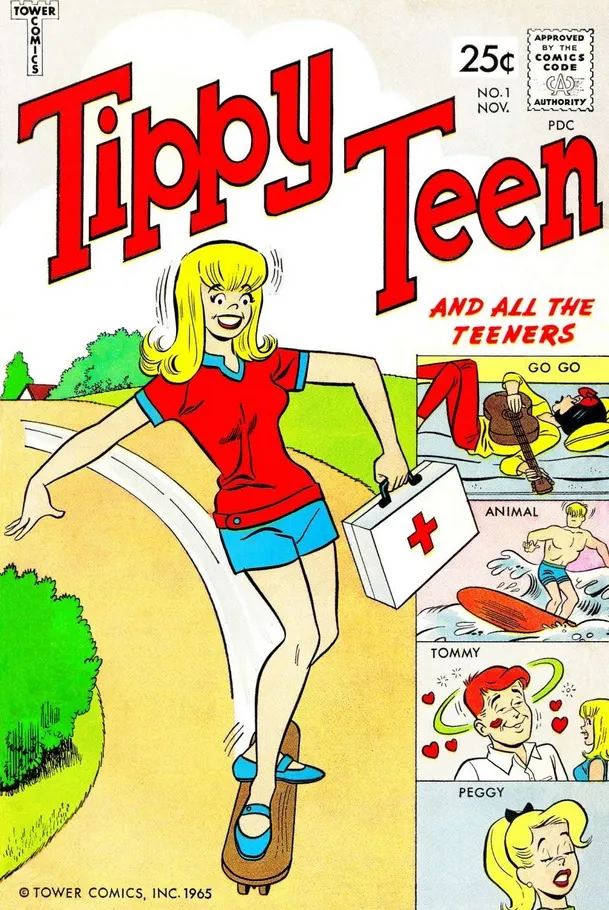
The Context
Archie has been popular since the 1940s. Like, really popular. According to Michelle Nolan’s book Archie’s Rivals in Teen Comics, 1940s–1970s, well over a hundred teen humor comics sprang up in the first 30 years after Archie‘s debut, trying to profit off that winning formula. But, since the mid-70s, Archie has been left to play the field alone as his “rivals” faded into obscurity.
Tippy Teen — billed first as “America’s Teen-age Sweetheart,” and later as “America’s Swingiest Teener” — was one of the last knockoffs to try her luck.
The Creators
According to Nolan, Tippy Teen‘s publisher, Tower Comics, was the only new comics publisher to hit the scene in 1965. I already talked about Tower back when I reviewed their other flagship title, T.H.U.N.D.E.R. Agents. In brief, Tower only existed from 1965 to 1969, during which time they ambitiously tried to create their own superhero universe and their own teen humor universe. Obviously, their success was short-lived, despite the truly ridiculous amount of talent they managed to attract.
In the case of Tippy Teen, that talent took the form of just about everybody who worked on vintage Archie. Harry Lucey? Check. Dan DeCarlo and Vincent DeCarlo? Double check. Samm Schwartz? Checkity-check. They even got Jack Mendelsohn, who would go on to write for the Sabrina the Teenage Witch animated series, among many other things. Later issues prominently feature work from Doug Crane, future animator on shows like He-Man and The Smurfs.
In other words, the creative team (at the start of the book, anyway…) is ludicrously talented, and I have very high expectations for this comic now.
The Comic
I can’t say much for the series’ originality: when I said it was an Archie knockoff, I meant it. It stars Tippy Teen (yes, that is her full name), a boy-crazy blonde with a knack for wackiness. Her friends include Tommy Trippit, her clumsy red-headed boyfriend; Go-Go West, a cynical, snarky brunette; Peggy Fleagle, Tippy’s glamorous and snobbish rival; Animal, a jock with muscles bigger than his brain; Egghead Eggers, nerd-in-residence; and Ashley Hartburn, the school bully. Also, may I just say those names are exquisite.
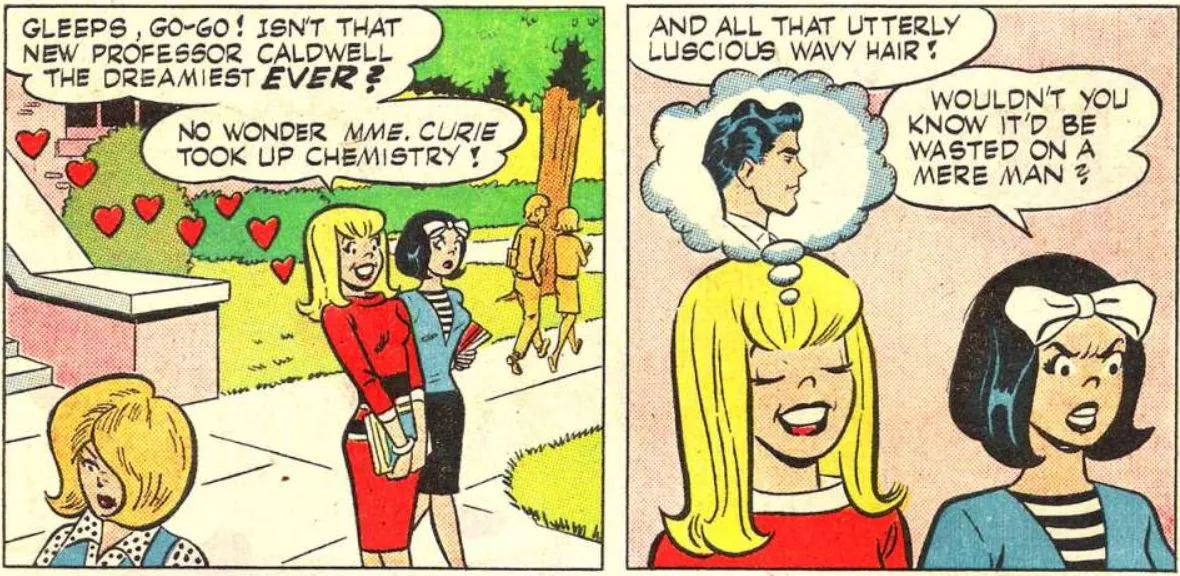
It’s less than original in other ways, too: the creators straight-up plagiarize stories from other teen humor comics. Look at the first panel from the story “Negative Results” in Tippy Teen #14, published in 1967.
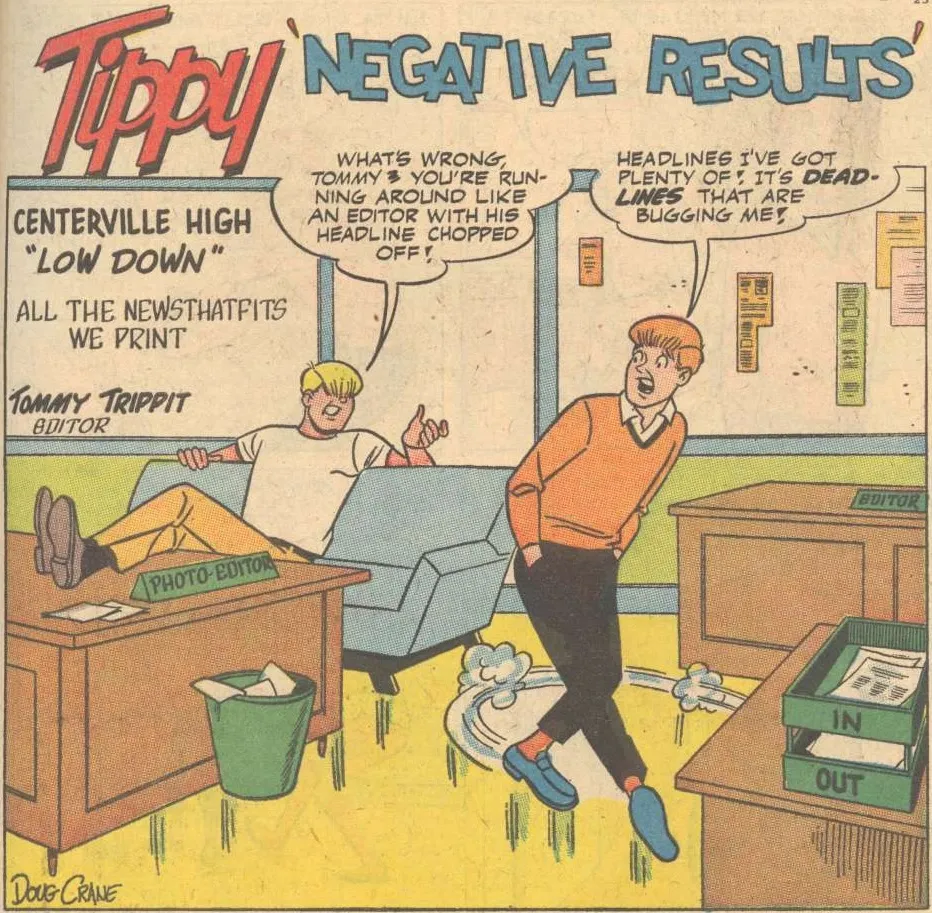
Now let’s play Spot the Difference with the first panel from the story “Front-Page Stuff” in Quality Comics’ Candy #63, published in 1956.
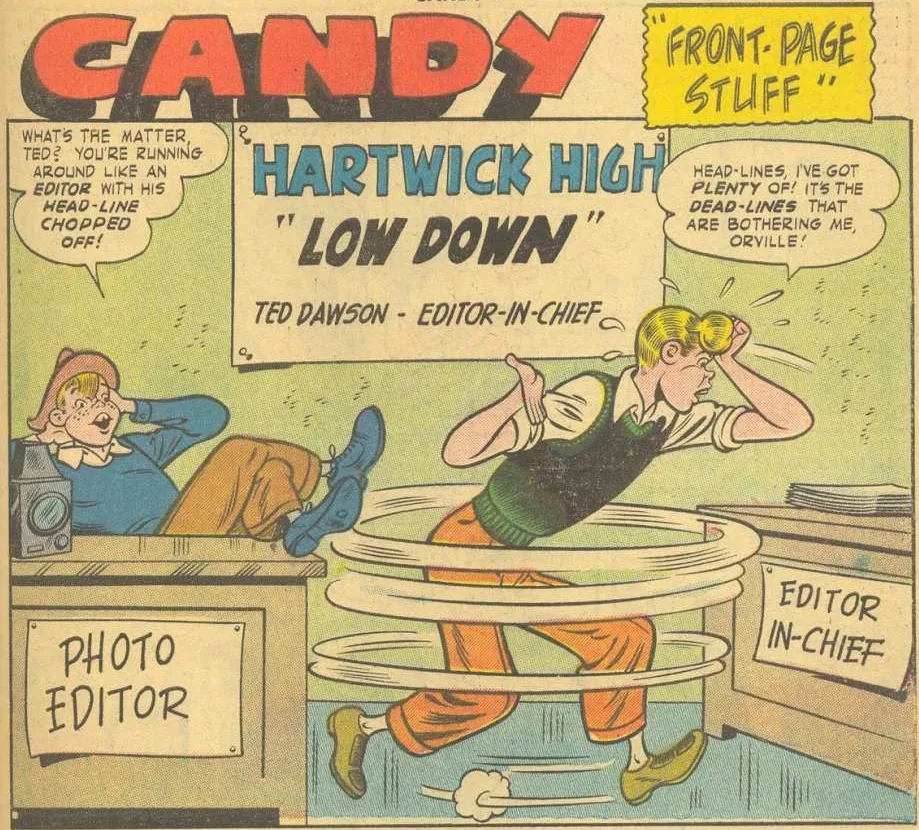
Even the name of their hometown, Centerville, appears to have been stolen from Marvel’s Patsy Walker, though I will concede that it’s not exactly a super-distinctive name and the replication could be coincidence. (Patsy would later go from being Marvel’s queen of teen comedy to the superhero Hellcat!)
Nolan indicates this type of swiping wasn’t unheard of in teen humor comics, but what gets me is how blatant and shameless it is!
The style of humor in Tippy Teen will be very familiar to Archie fans: lots of punny titles (“It’s a Smell World,” etc.), miscommunications, pratfalls, and general hijinks. The plots are familiar, too: the characters deal with school assignments, un-groovy parents, fleeting opportunities for fame and fortune, sports try-outs, battles of the sexes, and of course an unhealthy dose of romantic rivalry.
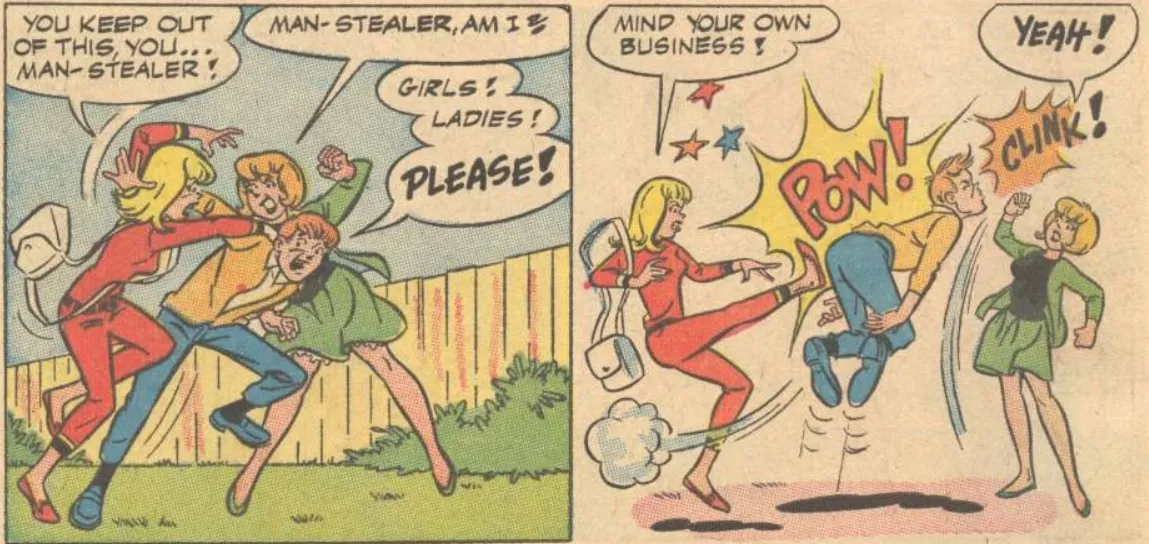
Go-Go initially eschewed romantic entanglements, but that sadly went out the window. I guess the idea of a pretty girl who didn’t start panting at the sight of a hot new volleyball coach was too much for the creators to handle. That’s seemingly confirmed in Issue 6, when we meet another girl uninterested in romance: Tiny, a fat, loudmouthed “man-hater” who ends up falling out a window — and who also suddenly gains an interest in boys in later issues.
The writing in the first few issues is a bit edgier — you know, comparatively speaking — than in the later issues. One early story revolves around Tippy convincing Tommy to kill a turkey for Thanksgiving. (He accidentally runs it over with his car — yum, roadkill!) And then there’s this exchange from Issue 4, when Tippy buys a fake love potion to sabotage’s Tommy’s date with another girl.

This, like with Go-Go’s lack of interest in boys, is quickly jettisoned, though the covers of later issues show some creativity: Issue 14 is uncolored so readers could color it in themselves, and Issue 16 shows Tippy strolling with a black-and-white photo of the real-life model Twiggy. The very last covers are just desperate, with Tippy appearing in bikinis and other sexy outfits.
Tippy Teen was published from 1965 to 1969 — basically as long as Tower Comics was around. It was much longer than your average comic and included a lot of extra features, like amusing reader letters, party tips, splash pages of the girls modeling reader-designed fashions, and a “Dear Tippy” advice column. (The quality of the advice ranges from decent to outdated to appalling: in Issue 16, in response to a girl who’s being teased for being “rather chubby” and having curly hair, “Tippy” tells her to “get on the beam” and start dieting and straightening her hair!!)
Another feature — originally called “Star Time” but left untitled in later issues — profiles popular celebrities of the day. At least one edition appears to have been written by someone’s overenthusiastic teenage daughter. That is a compliment.
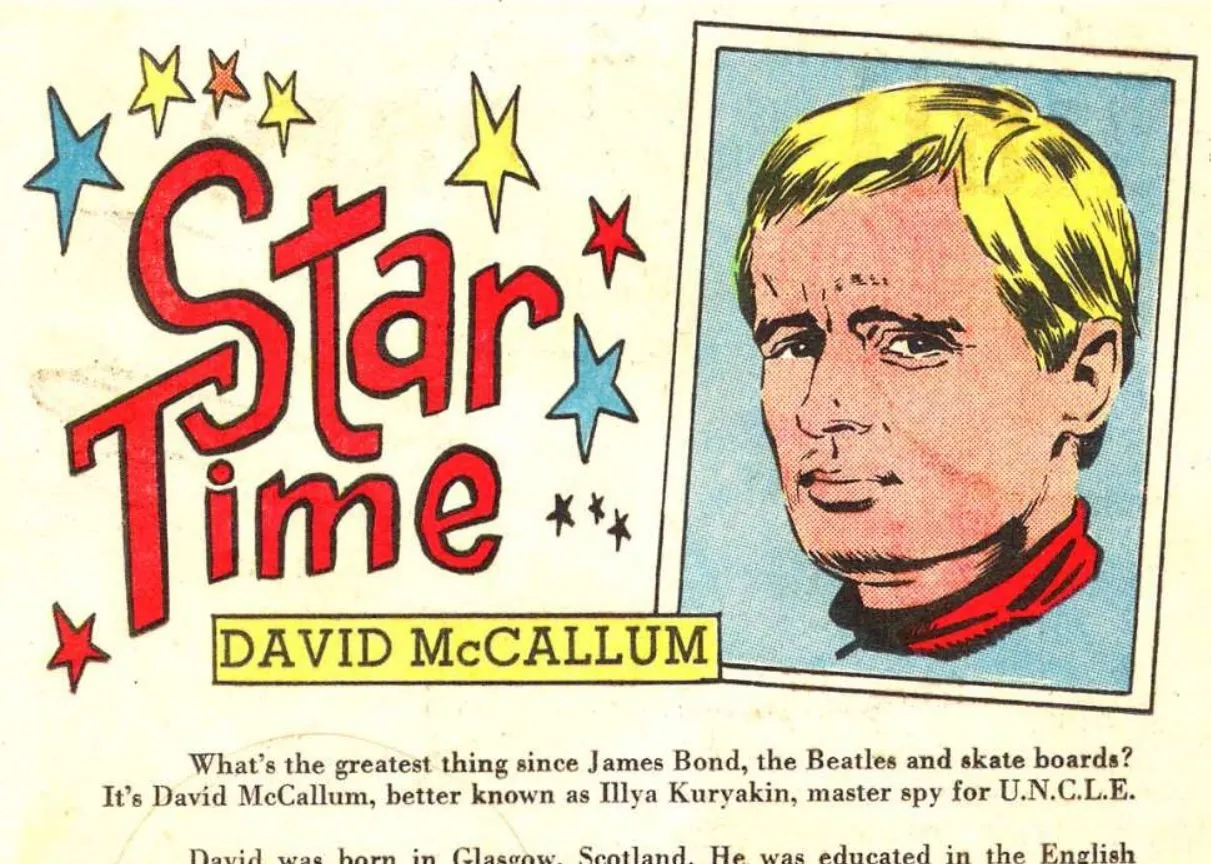
Wow, greatest thing since James Bond, the Beatles, AND skateboards? The ’60s sure were a decade.
Like T.H.U.N.D.E.R. Agents, Tippy Teen inspired spinoffs: Teen-In and Tippy’s Friends Go-Go and Animal. I haven’t read them, but they seem like more of the same.
Alas, signs of trouble begin cropping up by Tippy Teen‘s first anniversary: they start reprinting older stories, the art quality in some stories declines sharply, and they publish the book fewer and fewer times a year. T.H.U.N.D.E.R. Agents experienced a similar decline until Tower Comics went under.
The Legacy
Tippy Teen is a little too steeped in its era to feel timeless like Archie now does. The names, while hilarious, are definitely of their time. The characters are obsessed with ’60s culture: the girls go gaga for every long-haired musician who comes to town, and in Issue 5, Tippy forces Tommy to give up his “ginky” haircut for a “kooky” one, which he kept for the rest of the series.
Oh, and did I mention the slang? Most of it is pretty funny, though a truly offensive word does slip in on rare occasions.
I can only imagine Tippy Teen would have grown out of this if it had lasted longer. Still, Tippy did have a bit of an afterlife: another publisher ran reprints of the series after changing Tippy’s name to Vicki. Beyond that, it doesn’t seem to have left much of a mark, which is understandable but a shame nonetheless.
If you like Archie at all, I strongly recommend this series. It is genuinely a lot of fun, especially in the first few issues. In an industry awash with second-rate Archies, Tippy Teen stands out with its energetic art and solid jokes.
Want more vintage goodness? Check out previous editions of RCR: Race for the Moon and Stamps Comics!













